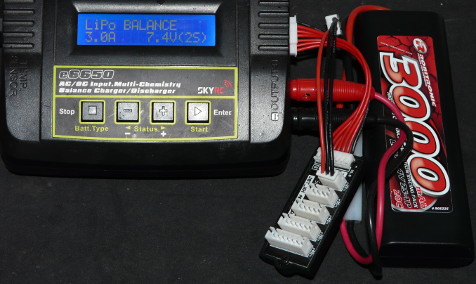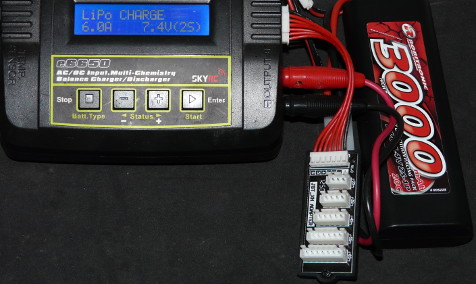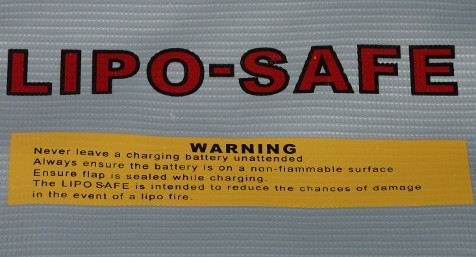Charging and balacing / Discharging / Storing a lithium battery pack
The process of charging a lithium battery is known as the most delicate (ie dangerous) when using a lithium battery. This is why it is recommended to strictly follow some security instructions whenever a lithium battery and a charger are involved.
 Setting up / Checking parameters on a charger
Setting up / Checking parameters on a charger
This is the first essential step, the one that must always be performed before plugging the battery pack to the charger.
In fact, LiFe and LiPo batteries have very different specifications you must respect in order not to run into serious problems. As a consequence, only use chargers supporting the battery type(s) to charge. Obvious? Well, you can easily find crazy advices on internet, like people claiming you can use a NiCd program to charge LiFe batteries. Or even worse. You know what? Playing with a loaded gun is less dangerous (in addition, you won't bother the fire department, won't burn the house or apartment to ashes and won't play with other people's life). Not saying that playing with guns is safe, of course.
Here is an detailed overview of the different battery type specifications:
| NiCd | NiMH | LiFe | LiPo | |
| Voltage / cell | 1.2 V | 1.2 V | 3.3 V | 3.7 V |
| Voltage max / cell | <1.5 V | <1.5 V | 3.6 V | 4.2 V |
| Voltage min / cell | 0.85 V | 1.0 V | 2.5 V | 3.0 V |
| Recommended cut-off value / cell |
1.0 V | 1.1 V | 3.0 V | 3.3 V |
Here, you only have a preview about why the chargers have a specific program for each type of battery, because there are additional characteristics specific to each battery type that need to be respected.
In concrete, almost every charger uses the same kind of operating instructions:
- select mode (= battery type)
- select program (charge, discharge etc...)
- program specifications
- select program (charge, discharge etc...)
Anyway, a serious reading of the charger's manual is required!
Never skip the warning messages: you won't get things like "don't place live animals in the micro-wave oven". All warnings you will find require your attention and need to be attended.
Now, the steps to follow in chronological order to charge a LiFe or LiPo battery:
 Choose the correct program according to the battery type
Choose the correct program according to the battery type
The battery type is always written on the pack label. In case the label has disappeared, you are left with only two options: either you do know for sure the battery type (and you don't have the slightest doubt about it), either you don't know or you have a doubt. First case, re-write the type onto the pack, it will avoid any further doubt. Second case: don't risk your life, don't use this pack anymore and properly dispose of it for recycling.
Caution, by default, most chargers will automatically recall the last program you used: always be careful and always check the charger mode is correct for the battery type.
 Select the program
Select the program
After selecting the mode according to the battery type, you need to select the program among all those available from your charger. As a matter of fact, let's immediately eliminate several of these programs ![]() .
.
- Charge: NEVER USE IT, see Balancing program instead.
- Fast Charge: NEVER USE IT, see Balancing program instead.
- Discharge: NEVER USE IT. LiPo and LiFe batteries have no "lazy memory" syndrome (real or pretended). Discharging a LiFe or LiPo battery pack is useless: it won't help preserve their lifetime or performance at all. On the other side, discharging represents both a risk of mistake in the minimum voltage value setup per cell (which will definitely deteriorate the cells and turn the pack into a fire-starter) and the risk of not being able to immediately recharge the pack in order to charge the cells back to charged or storage values. Which also leads to destroy the battery pack and to turn it into a fire-starter. So, the best way of all, just definitely forget the discharge feature.
OK, done ![]() . Now let's review the only two programs of interest:
. Now let's review the only two programs of interest:
- Balance: this is THE program to select to charge a LiFe or LiPo battery because it features a voltage balancing between the cells. The balancing is required for a safe use since only the overall battery pack voltage is monitored when using the Charge and Fast Charge programs. As we already saw, the cells do not discharge synchronously: well, know that they do not charge synchronously either. Charging without balance generally leads to over-volting one of the cells (which destroys it). Over-volting a cell during charging is the main cause of lithium battery packs destructions.
Correct: balanced charge at 1C

Dangerous: charge without balance at 2C

Let's start with the second photo which is the worst possible example: the battery pack is a 3000mah LiPo, so 1C = 3.0A. The charge voltage is set to 6.0A, which are 2C for this pack: even if some manufacturers claim their battery packs can accept 2C or even 5C charge rates, the elementary caution is to always charge at only 1C. No more (danger), not less (useless, in addition to make the charge last longer). Next mistake: the charging program is without balance, reason why the balance lead is not connected to the charger balance socket. To make it short, this is about everything you must not do when charging a LiPo or LiFe battery pack (well, I could also have selected the wrong battery type to make sure I would start a fire).
First photo now: the selected program is the one with balancing, the balance lead is connected to the charger balance socket and the charge voltage is set to 3A for a 3000mah pack. So the first photo shows a proper charge process... almost. In fact, for this photo, I needed the pack to be visible: in practice, the pack must always be wrapped into a LiPo Safe Bag (perfectly suits LiFe packs too). As a reminder, do not forget the charging process is known as the most dangerous period in the life of lithium batteries (LiPo and LiFe).
So, still for this 3000mah LiPo pack, the correct charging method is this one:
Correct: balanced charge at 1C with a LiPo Bag

The warning statement found on the LiPo Bag

You can still improve security by placing the charger and the pack on a non-flammable surface during the charging process (tiled-floor or concrete for example). On the second photo, the security warning on the LiPo Safe Bag: read it carefully, it says it all.
A LiPo bag can easily be found for less than 5€, some even allowing to store several packs (nice, but if a pack catches fire, all the others will too). Security at this low price, it can't be ignored.
Also, NEVER leave the pack in the chassis when charging..
Now, charge values with balance:
LiFe battery
Charging voltage: 1C
Voltage: 3.3V (1S), 6.6V (2S) depending on the pack
Voltage per cell after charging (max): 3.6V
LiPo battery
Charging voltage: 1C
Voltage: 3.7V (1S), 7.4V (2S) depending on the pack
Voltage per cell after charging (max): 4.20V
Charging with balance provides two additional important security features. The first one happens even before the beginning of the charging process: if the specified voltage of the pack (1S, 2S...) is incorrect, the charger will detect it through the balance lead and will immediately go in security mode. The second is about a strict respect of the maximum voltage per cell during all the process of charging: 3.60V for LiFe or 4.20 for LiPo.
Always unplug the charger as soon as the charging process ends.
Never leave a pack "resting" while connected to the charger once the charging process has ended: the charger always beeps once the charge is over. And as you must never leave unattended a pack while it is charging, this shouldn't be an issue.
Always wait 1 to 2h after using a battery before recharging it.
The LiFe / LiPo cells slightly expand when being used: that is normal, we saw that earlier. Always wait 1 to 2h, the time for the cell internal chemistry to go back into their "idle" state after their excitation state when being used.
If you do not respect the delay between the use and the recharge, the cells will expand more. As we already saw that cell expansion is a problem leading to their destruction, so be patient.
Again, LiFe and LiPo batteries are time bombs when they are not being cared. When correctly used and cared, the risks are reduced to almost none. But they require stricter discipline and security measures than the old NiCd and NiMH. RC is an enjoyable hobby: don't turn it into a weapon due to negligence.
- Storage: just like NiCd and NiMH, LiFe and LiPo batteries suffer from self-discharging over time (much less than NiCd and NiMH though).
Any LiFe or LiPo pack that will not be used for over 7 days needs to be charged in storage mode. So, either you run your model(s) every week end, or you charge your LiFe / LiPo packs in storage mode between two runs => that simple ![]()
The storage mode is used to adjust the cell voltage either by charging or discharging it until it reaches about 75% of its capacity. This adjustment of each cell voltage drastically reduces the self-discharging effect, but mostly, it sets the cells voltage at a value which is the one that best guarantees the greatest "natural" stability of the cell internal chemistry. In addition, you will have to check each cell voltage every 3 months of storage in order to make sure it didn't change (in winter for example, when battery packs may remain unused for long periods).
Now, the storage values per battery type:
LiFe battery
Voltage: 1.0A
Voltage: 3.3V (1S), 6.6V (2S) depending on the pack
Storage voltage per cell: 3.3V
LiPo battery
Voltage: 1.0A
Voltage: 3.7V (1S), 7.4V (2S) depending on the pack
Storage voltage per cell: 3.85V (+/- 0.05V)
We are done with the storage function on the charger. Now, let's talk about how to physically store your battery packs at home. Here too, there are simple rules to respect, including for packs already in storage mode.
- Non-flammable: the most important word. The location needs to be fireproof: no wooden drawer or shelf, no plastic box. The best would be to store every pack in a LiPo-Safe Bag and each LiPo-Safe Bag inside a metal box located onto a non-flammable surface (metal, tiled-floor, ground, concrete...). Well, the cost and the space management at home may not allow to multiply the security measures: depending on your situation, you can store several packs into one single LiPo-Safe Bag as long as you still can close the bag. Also think about metal tin trunks or military ammo cases (army surplus for example) or metal toolboxes to store your battery packs. Anyway, place them on a non flammable surface, the further from anything that could catch fire, the better.
- Temperature: even though some people recommend to store battery packs in the fridge, this is not the best WAF solution
 (and not the safest: see next paragraph). Actually, the best storage temperature for lithium batteries is somewhere between 4 and 21°C in the shade (no need for obscurity, just avoid direct sunshine). For short periods (a few hours, for transportation for example), the batteries will resist to temperatures between -6 and 60°C without damage. From 75°C and over, LiFe and LiPo batteries can suffer permanent damage and can catch fire spontaneously (be careful: such a temperature is frequent inside your car when you park in full sunlight).
(and not the safest: see next paragraph). Actually, the best storage temperature for lithium batteries is somewhere between 4 and 21°C in the shade (no need for obscurity, just avoid direct sunshine). For short periods (a few hours, for transportation for example), the batteries will resist to temperatures between -6 and 60°C without damage. From 75°C and over, LiFe and LiPo batteries can suffer permanent damage and can catch fire spontaneously (be careful: such a temperature is frequent inside your car when you park in full sunlight). - Accessibility: think about the other persons who could reach the battery packs and manipulate them without due care, in particular young kids. You don't need a pitbull dog to protect your packs, but don't make it easy for young kids to reach them.
- Watch: even in storage mode, never abandon your battery packs. From time to time, check them to detect any suspicious puffing. Again, no need for a permanent video monitoring, but have a look over them every 3 months (while you control their voltage, for example).
We reviewed in detail what you need to know to safely and fully benefit from your lithium batteries. Even if this article is long, in the end, the rules to follow are quite few and are mainly common sense. The new LiFe and LiPo batteries can be dangerous due to their internal chemistry, but most of all, problems occurs due to human failure in using them properly (and the guilty silence of the RC industry in general). Yes, these new generation batteries require to be treated with more discipline than the old NiCd and NiMH (those being capable of leaks and explosions too in rare extreme conditions), but they offer greater autonomy and better performance. It is your choice to safely benefit from them.




